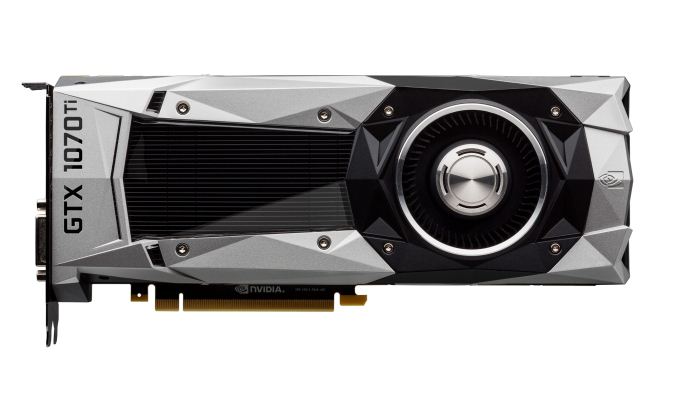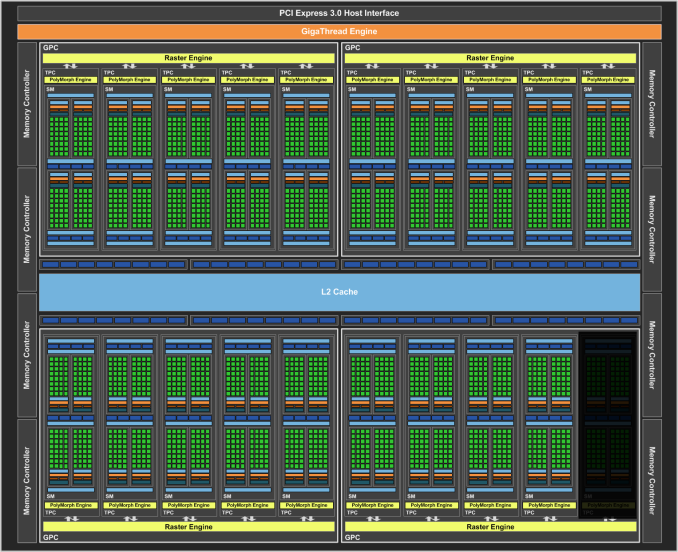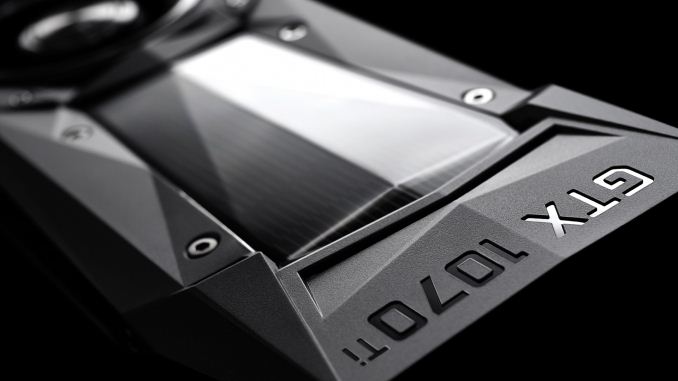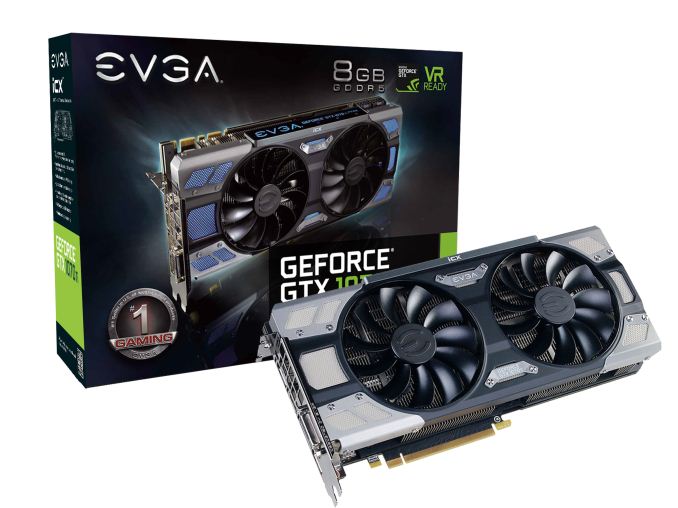The NVIDIA GeForce GTX 1070 Ti Founders Edition Review: GP104 Comes in Threes
by Nate Oh on November 2, 2017 9:00 AM EST- Posted in
- GPUs
- GeForce
- NVIDIA
- Pascal
- GTX 1070 Ti

Earlier this March, our GeForce GTX 1080 Ti review opened by noting that 2016 was a banner year for NVIDIA, with their execution in multiple fields resulting in record revenue. We mentioned all this not only because of the capstone nature of the GeForce GTX 1080 Ti, but also in how the card positioned NVIDIA for the rest of the year, running up the score alongside the GeForce GTX 1080 and GeForce GTX 1070.
Since then, what has changed? From AMD, we’ve seen the April release of the Polaris-based Radeon RX 500 series, still aimed at the mainstream market. And then finally in August, after teasers, architectural overviews, and a Frontier Edition or two, AMD launched their high-end Radeon RX Vega 64 and 56 cards, roughly targeting the GTX 1080 and 1070 respectively. So only the last few months have seen the first challenge to NVIDIA’s 1-2-3 position this generation.
Launching today, then, is the GeForce GTX 1070 Ti, announced last week when it was first available for preorders.
| NVIDIA GPU Specification Comparison | |||||
| GTX 1080 | GTX 1070 Ti | GTX 1070 | |||
| CUDA Cores | 2560 | 2432 | 1920 | ||
| Texture Units | 160 | 152 | 120 | ||
| ROPs | 64 | 64 | 64 | ||
| Core Clock | 1607MHz | 1607MHz | 1506MHz | ||
| Boost Clock | 1733MHz | 1683MHz | 1683MHz | ||
| Memory Clock | 10Gbps GDDR5X | 8Gbps GDDR5 | 8Gbps GDDR5 | ||
| Memory Bus Width | 256-bit | 256-bit | 256-bit | ||
| VRAM | 8GB | 8GB | 8GB | ||
| FP64 | 1/32 | 1/32 | 1/32 | ||
| TDP | 180W | 180W | 150W | ||
| GPU | GP104 | GP104 | GP104 | ||
| Transistor Count | 7.2B | 7.2B | 7.2B | ||
| Manufacturing Process | TSMC 16nm | TSMC 16nm | TSMC 16nm | ||
| Launch Date | 05/27/2016 | 11/02/2017 | 06/10/2016 | ||
| Launch Price | MSRP: $599 Founders: $699 |
MSRP: $449 Founders: $449 |
MSRP: $379 Founders: $449 |
||
As the third GP104 based GTX 10 series card, the GTX 1070 Ti comes 16 months after the release of the GTX 1080 and 1070, falling between them in price and performance. The end result is a shoulder-to-shoulder three card stack, all based on a Gx104 GPU, something that NVIDIA rarely offers historically. As a later-cycle product, the card also conspicuously follows on the back of AMD’s reentry into the high-end graphics space with RX Vega, and in that vein NVIDIA is comparing the GTX 1070 Ti to the Vega 56 directly.
At the time of their Vega launch, AMD matched up the Vega 64 against the GTX 1080 and the Vega 56 against the GTX 1070. Although the GTX 1080 Ti continues to rule the roost, in August we saw the air-cooled reference Vega 64 trade blows with the GTX 1080, while the reference Vega 56 edged out the GTX 1070 by around 8%, albeit with greater power consumption. In aiming at the Vega 56, the GTX 1070 Ti is angling at reversing that performance advantage.
As for the GPU itself, described earlier at last week’s announcement, the GTX 1070 Ti has GP104 as a 19 SM arrangement, four more SMs than the GTX 1070. This is combined with the GTX 1080’s higher 180W TDP, the GTX 1070’s GDDR5 memory and bandwidth, and clockspeeds somewhere in between. While the GTX 1070 Ti’s additional SMs provide more shading, texturing and geometry resources than the GTX 1070, this is balanced out by the memory bandwidth and ROP throughput staying at the same level. Consequently, the GTX 1070 Ti is setup to fare better in compute-bound games thanks to the extra SMs, as opposed to bandwidth- or ROP-intensive games.
By the numbers, the GeForce GTX 1070 Ti offers 19% more shading/texturing/geometry throughput than the GeForce GTX 1070, paired with no change in ROP throughput or memory bandwidth. Or to compare things to the GTX 1080, the GTX 1070 Ti offers 92% of the GTX 1080's shader/texture/geometry throughput, 97% of the ROP performance, and 80% of the memory bandwidth. For performance then, going by NVIDIA’s numbers, the GTX 1070 Ti is promoted as being around 15% faster than the GTX 1070 but 8% slower than the GTX 1080.
Whatever the real-world performance difference might be, the GTX 1070 Ti price is roughly in the middle between the GTX 1080 and 1070. NVIDIA’s Founders Edition is statically set at $449, but the official MSRP starts at that point, presumably going no higher than the low ceiling of $500 or so where GTX 1080 cards come into play. While it is notable that the GTX 1070 Ti Founders Edition doesn’t carry the traditional Founders Edition price premium, even a $50 premium would collide with $500 GTX 1080 models. And an MSRP at any lower price points would bump into the GTX 1070.
Given the narrow price and performance window that the GTX 1070 Ti is attempting to squeeze into, all GTX 1070 Ti boards are shipping with the same 1607MHz base/1683MHz boost reference clocks and overall, the number of SKUs will be more limited. The obvious consequence of factory overclocked GTX 1070 Ti’s is that those cards would overlap GTX 1080s on price and potentially performance, thus cannibalizing and competing with NVIDIA’s own products. Which begs the question as to why NVIDIA would force the issue in creating such a tightly-packed product lineup in the first place.
Looking at the pricing, performance, and positioning, it is clear that NVIDIA is shoring up their stack against any kind of AMD incursion. In particular, AMD was able to position the reference Vega 56 above the GTX 1070, but a GTX 1070 Ti now blocks that kind of encroachment with minimal collateral sales damage, provided that the card stays in between the GTX 1080 and 1070 in both price and performance.
In any case, NVIDIA is still pushing the card as a good overclocking card, but without factory overclocks, leaving it to the consumers to overclock with the usual third-party utilities. Thereby, they can avoid factory overclocked designs that could outright undermine the GTX 1080, but still market the overclockability. Incidentally, by having to stick so closely in the $449 - $500 range, AIB partners may not have the margins to offer over-engineered and costlier custom designs that would attract overclockers. And given the tightness of the price bracket, it may not be economical to test and validate truly high-clocking boards, only to sell them at significantly reduced margins. While some partner cards are advertising higher boosts via first-party utilities, or in the case of Zotac, "Factory Tested OC," at the moment it is unclear what those exactly mean. As a counterpoint, because the GTX 1070 Ti is utilizing GP104 and at the GTX 1080's TDP of 180W, partners can and are reusing their existing GTX 1080 designs, much like NVIDIA has done with their reference GTX 1070 Ti Founders Edition, as we will soon find out.
Another factor that Ryan brought up last week was chip yields of the GPU itself. After 16 months of yield improvement at TSMC, GP104 GPUs fabbed on the mature 16nm FF process may not have as many defective SMs as they used to. After all, NVIDIA and TSMC were able to fab the gargantuan 815mm2 GV100 with high enough yields to be commercially viable. And GP104 happens to be a GPU that pops up in a number of places outside desktop GeForce graphics cards, including notebooks, Quadros, and even in mining cards as P104s.
And on that note, cryptocurrency mining demand has drastically affected graphics card supply and demand this year, actually leading to the creation of mining-specific cards. Even NVIDIA’s cards, which typically are less efficient or performant at cryptomining than AMD’s, have gone through shortages this year. Cryptomining continues to have an impact on prices and availability. But where the GTX 1070 Ti stands for miners is a bit of an open question; the GTX 1080 continues to be hampered by its GDDR5X memory as it cannot be fully utilized by Ethereum, but the GTX 1070 Ti does not offer memory bandwidth improvements over the GTX 1070.
Ultimately, the starting MSRP is $449, where the Founders Edition is priced at, and a number of custom cards are available today from partners. Looking at the prices, $449 is unsurprisingly where partner blower cards fall. While only a few GTX 1070 Ti's touch the $499 mark, this puts it very close to custom design GTX 1080s; at the time of this writing, the MSI GeForce GTX 1080 Armor 8G and Duke 8G are priced at $509, excluding the Armor 8G's current $10 rebate that brings it down to $499. At the same price of a custom cooled GTX 1070 Ti, consumers may also buy custom cooled GTX 1080s. So custom GTX 1080s do drift down here, and partner GTX 1080 blowers are commonly found in the low $500s as well. As for high-end GTX 1070s, EVGA GeForce GTX 1070 FTW Hybrid and standard Hybrid are both at $500, with liquid cooler and fan hybrid cooling system.
| Selected Partner GeForce GTX 1070 Ti Launch Cards | |||
| Card | Advertised Boost | Launch Price | |
| NVIDIA GTX 1070 Ti Founders Edition | 1683MHz | $449 | |
| ASUS GTX 1070 Ti Turbo (Blower) | 1683MHz | $449 | |
| ASUS GTX 1070 Ti ROG Strix 8G | 1721MHz (GPU Tweak) |
$499 | |
| ASUS GTX 1070 Ti ROG Strix Advanced Edition (A8G) | 1759MHz (GPU Tweak) |
$499 | |
| EVGA GTX 1070 Ti Gaming (Blower) | 1683+MHz | $449 | |
| EVGA GTX 1070 Ti FTW2 | 1683+MHz | $499 | |
| EVGA GTX 1070 Ti SC Black | 1683+MHz | $469 | |
| EVGA GTX 1070 Ti Hybrid | 1683+MHz | $529 | |
| GIGABYTE GTX 1070 Ti Gaming 8G | 1733MHz (AORUS Engine) |
$489 | |
| MSI GTX 1070 Ti Aero (Blower) | 1683MHz | $449 | |
| MSI GTX 1070 Ti Duke 8G | 1683MHz | $469 | |
| MSI GTX 1070 Ti Gaming 8G | 1683MHz | $489 | |
| MSI GTX 1070 Ti Titanium 8G | 1683MHz | $489 | |
| Zotac GTX 1070 Ti AMP! | Factory Tested OC: 1753MHz GPU, 2102MHz Memory |
$469 | |
| Zotac GTX 1070 Ti AMP! Extreme | Factory Tested OC: 1833MHz GPU, 2202MHz Memory |
$499 | |
| Zotac GTX 1070 Ti Mini | 1683MHz | $449 | |
As for the competitive landscape, the GTX 1070 Ti is squaring off with Vega 56. Aside from price and availability, the GTX 1070 Ti has the advantage of launching with custom partner cards, whereas partner RX Vega cards have yet to hit the market. RX Vega 56 is currently only available with a reference blower, which may not be an ideal matchup against custom designs. But for today, we are looking at the GTX 1070 Ti Founders Edition, pitching reference card against reference card.
| Fall 2017 GPU Pricing Comparison (Still Crypto-Crazy Edition) | |||||
| AMD | Price | NVIDIA | |||
| Radeon RX Vega 64 | $509 | GeForce GTX 1080 | |||
| $449 | GeForce GTX 1070 Ti | ||||
| Radeon RX Vega 56 | $399/$409 | GeForce GTX 1070 | |||
| Radeon RX 580 (8GB) | $289 | ||||
| $259 | GeForce GTX 1060 (6GB) | ||||





_thumb.jpg)




_thumb.jpg)
_thumb.jpg)
_thumb.jpg)












78 Comments
View All Comments
Bp_968 - Tuesday, December 26, 2017 - link
I know this is an old article but I had to comment on the desktop space being "stagnant". That's mostly true for general consumers and corporate buyers but absolutely not true for med/higher end systems targeted at gamers (and miners). Those two markets are pushing massive demand for high performance desktop CPUs and GPUs (which you can see in AMD and NV's pricing and availability on their GPUs). The year over year performance improvement in CPUs is pretty boring right now but GPUs are still pretty exciting and still seem to have some big leaps left in them. I'm interested in seeing if Intel is going to be able to bring out a capable 3rd option in the discrete GPU space in the next few years. Their track record isn't good so far but having a 3rd player in the GPU/Compute space could really shake things up.I'm with you on the Ryzen APUs. If AMD can manage to make an APU with 1050/1060 level performance that fits in a thin and light notebook that could be a real game changer for many of us. I've mostly given up on gaming laptops because they end up being more of a portable then a mobile system and for most things I do on a laptop I'd just prefer the really thin and light setup. If I can manage to get both thin and light *and* decent gaming performance (even if you need to be plugged in to maintain battery life when gaming) then that would be killer.
The only problem I see is the push for 4k monitors on these little laptops. No APU is going to be able to push 4k anytime soon, but I've never tried gaming at 1080p on a 4k panel and since its still a square pixel at 1080p, it might look fine, in which case it would be a non-issue.
Hxx - Thursday, November 2, 2017 - link
That just makes no sense and heres why. First off, If you're paying over MSRP then you are not paying Intel or Amd or Nvidia or whatever. You are paying that distributor or the retailer or whoever gets those cards from the manufacturer. Second, if the manufacturer quotes an MSRP then this price already covers the costs and whatever the manufacturer wants to charge you for.It has nothing to do with whether or not you can afford it. Thats irrelevant. And if you're wondering WHY the vendor charges over MSRP is because 1) they can, 2) they know the demand is high so they know there are suckers like you who are willing to pay.
"Bullwinkle J Moose" - Thursday, November 2, 2017 - link
Higher prices would destroy AMDTo demand a higher price, they would need to compete with NVidia with cards that ran cooler/quieter, used less power and outperformed NVidia cards for the same price
That's just not happening anytime soon
Hixbot - Thursday, November 2, 2017 - link
The MSRP seems a bit high. The MSRP is a bit irrelevant as miners will push up the price even further.For me, it's a still a good purchase because of the blower cooler which I need for my SFF PC, all other Founder Edition cards are unavailable.
Wwhat - Sunday, November 12, 2017 - link
I think any device relying on Nvidia or AMD drivers/software should reflect that, and they should not dare to sell anything over $500.Samus - Thursday, November 2, 2017 - link
I’m glad I’m not the only one who finds it ridiculous that the mainstream cards are now $100-$150 more than they used to be...These price brackets have just gotten ridiculous. I’d like to go back 15-20 years to when the most expensive cards were $200 (TNT2 Ultra :)
Hxx - Thursday, November 2, 2017 - link
It wasnt like this a year ago. This year we just have a couple phenomenons overlapping and the result is this...a market where the demand is high and supply is low. Maybe next year things will change but this year is not consistent with the past couple years where a videocard would drop significantly in price 6 months after release.BrokenCrayons - Thursday, November 2, 2017 - link
I remember splurging on an original TNT with 16MB of VRAM. It was a Diamond Viper V550, I think...but paying $130 or so for it back then felt like an awful lot. It was passively cooled by a tiny little heatsink, but was among the highest performing video cards at the time. Heh, I did want to shove a pair of Voodoo2s in the system behind it for Glide titles. Anyhow, I think economic inflation can account for some of the cost increase in higher end video cards, but certainly not all of it.webdoctors - Thursday, November 2, 2017 - link
The TNT2 was awesome and the best bang per buck at the time. However, the average price of gas (including state taxes) was $1.14 in 1999.https://www.statista.com/statistics/204740/retail-...
Now its $2.14. The Feds have been printing money so fast its essentially become water and diluted. That's why gas and video cards are going up (its true inflation, not the one fed by propaganda outlets). Unless you switch to using the gold standard where it was $290 in 1999 and now its ~$1500.
https://goldprice.org/gold-price-usa.html
So really if you wanted to buy the TNT2 today, instead of $200 it would be $400+, in short get the gtx1060 6gb and be happy.
RiZad - Monday, November 6, 2017 - link
counting for inflation they are ~1% more expensive. based on the tnt2 ultra that launched at $299 not $199